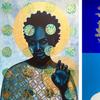A Recently Discovered Trove of Paintings Reveals A Troubled Artist’s Passion for Creative Expression
- BEVERLY HILLS, California
- /
- February 18, 2019
To honor her late brother’s legacy, Laura Ornest, a former KNX 1070 radio reporter, is mounting an exhibition featuring more than 200 of his extraordinary paintings. All proceeds from sales will benefit eight prominent charities and cultural institutions with which Rustic Canyon residents Laura Ornest and Rick Leslie, her architect husband, are involved.
“Mo’s Show: A Celebration of the Life and Work of Maury Ornest” will be held from noon to 5 p.m. on Saturday, Feb. 23, and Sunday, Feb. 24, at 524 N. Elm Dr. in Beverly Hills, where Maury Ornest lived and painted.
The artwork — much of which features whimsical motifs of flying fish, baseball and patriotism — paints a portrait of a man who exulted in life even after his descent into severe mental illness. Maury died of heart disease last summer at age 58.
In 1977, at age 17 and straight out of Beverly Hills High School, Maury Ornest became the youngest draft pick in professional baseball history. He chose instead to go to college on a baseball scholarship. While playing for UC Santa Barbara, he was drafted 76th in the country and signed with the Milwaukee Brewers organization. He played in the minor leagues for the Brewers from 1980 to 1982 and showed great promise as an outfielder until injuries ended his career.
At 23, Maury began working in the business office of his father, Harry Ornest, a transplanted Canadian who had recently bought the St. Louis Blues hockey team and its arena. Over the next few years, Maury suffered breaks from reality and paranoia. His mental challenges caused him to isolate himself from friends and family.
After Maury’s death, family members discovered more than 1,000 paintings and dozens of sketchbooks in his house and a storage unit. The family had been aware that he painted but had had no idea of the extent of his work. “I believe it’s time to show the world how my brother, while enduring severe mental illness, was still able to express joy and vibrancy, hopefulness, silliness and even whimsy,” Laura Ornest said. “I want to do for him what he couldn’t do for himself.”
Maury’s art became his way of staying connected to the world. Numerous journal entries detail how art kept his dreams for recovery alive. Why did he paint? “Passion, need, survival, love, adoration, God, giving, emote, hope, desperation, health, friendship, trust, humanity, fantasy (sometimes), relationships, company. But only from every part of me and my soul. No choice but to paint.”
Stephanie Pryor, an artist who helped to curate the exhibition, taught Maury at a UCLA Extension creative drawing workshop in 2010 and continued working with him privately until 2012. “I noticed right away that Maury had a special style,” Pryor said. “His work brings emotional joy to the viewer. His sense of optimistic determination resonates through each painting.”
To curate the show, Ms. Ornest and Mr. Leslie called upon Paige Wery, the founding director of L.A.’s The Good Luck Gallery, which specializes in Self-taught art including Outsider, Visionary and Folk, to assist them in selecting the paintings in the show. “We poured our hearts and souls into the daunting task of organizing his work,” says Mr. Leslie, “and felt we needed the expertise of a professional gallery owner.”
All proceeds from sales will benefit the following organizations: Beyond Differences, Craft Contemporary (formerly the Craft and Folk Art Museum), Didi Hirsch Mental Health Services, InsightLA, Jewish Family Service of Los Angeles, Kehillat Israel, the Friends of the Semel Institute at UCLA and Vista Del Mar Child and Family Services.
About Maury Ornest
Born in Vancouver in 1960, Maury was the youngest of four children of Harry and Ruth Ornest, who moved the family to Beverly Hills two years later. As a boy, Maury was known for his uncanny ability to mimic celebrities and friends. He and Harry shared a love of baseball, and Harry drilled Maury and his brother Mike for hours on end on how to field, bunt, steal bases and execute a double play. As a switch hitter, Maury became a star player and was the 76th pick in the professional baseball draft. He attended college and then played minor league baseball until a concussion ended his career. At 23, Maury began working in the business office of his father, who had recently purchased the St. Louis Blues hockey team and the arena where it played. Over the next few years, Maury began to experience the world as a hostile place. He suffered breaks from reality, and his life changed almost overnight. His supportive family searched desperately for effective treatments. In his mid-30s Maury began taking art classes at Otis College of Art and UCLA Extension, along with private instruction. He shared his love of creative expression with his mother, a passionate art collector. Hundreds of sketchbook pages demonstrate his fascination with and focus on the creative process. In the last two decades of his life, his output showed the depth and breadth of his understanding of art history, as well as his need to express himself creatively. His optimism is evident in the joyous nature, wit and vibrant colors of his paintings.
















